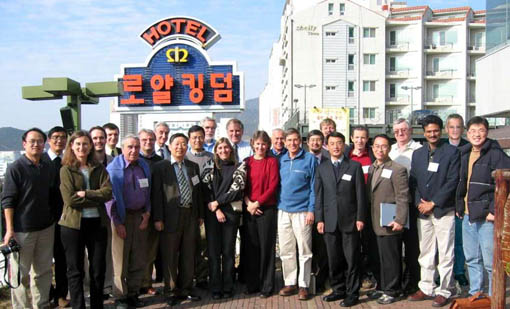

|
|
 Click on image for larger view The IOCCG Committee met for the 11th time in Busan, South Korea (11-13 January 2006). The meeting was hosted by the Korean Ocean Research and Development Institute (KORDI) and was attended by 29 Committee members and invited guests. The IOCCG Chair was officially handed over from Dr. Trevor Platt, Chairman of the IOCCG Committee since its inception, to Prof. James Yoder (Woods Hole Oceanographic Institution, USA). Dr. Platt was congratulated for the great legacy that he had established over the past 10 years. The status of the various IOCCG working groups was reviewed and Committee members were pleased to note that three working groups were ready to publish their monographs this year. A new working group on Phytoplankton Functional Types (PFTs) was established, to be chaired by Cyril Moulin (LSCE/IPSL, France). Committee members were also updated on the status of the various current and planned ocean-colour missions. Further details about the meeting can be found in the Minutes on the IOCCG website.
One of the requirements of Affiliated Programs of SCOR is the regular rotation of scientific committee members. Three scientific committee members (Vivian Lutz, Ian Robinson and Ron Zaneveld) rotated off the Committee and were replaced by Milton Kampel (INPE, Brazil), Samantha Lavender (University of Plymouth, UK) and Mark Dowell (JRC, Italy). Curtiss Davis (Oregon State University, USA) was invited to serve a second term. We officially thank the three retiring members for their hard work and contributions over the past three years and extend a warm welcome to our new Committee members.

The first GlobCOLOUR user workshop is tentatively planned for 4-7 December 2006, at the Laboratoire d'Océanographie de Villefranche (LOV). The aim will be to have not only scientific participants, but also end user organisations interested in the products and near-real time service for activities such as data assimilation into local and global oceanographic models. If you are interested in attending or receiving more information about the workshop, please contact: service@globcolour.info. Further information on the GlobCOLOUR Project can be found at http://www.globcolour.info
|

The Malaysian Ocean Colour Portal is a new website set up by C. K. Tan (Nagasaki University)
to promote ocean colour studies in Southeast Asian waters and to generate regional cooperation in the area. The web site was recently updated and includes a bibliography of scientific papers dealing with remote sensing in the Malaysian and Southeast Asian wates, as well as information on red tides in SE Asia, ocean colour research activities in Malaysia and a wealth of other information. Please use the following link
At the recent IOCCG meeting, participants were informed about two planned geostationary platforms (South Korea and USA) which are scheduled to carry ocean colour sensors.
NOAA's next series of Geostationary Operational Environmental Satellites (GOES), the GOES-R Series, are targeted to begin launching in 2012. Each will carry operational instruments for observing weather, as well as a number of other instruments that will have vastly improved capabilities in regards to coastal water imagery. It is planned that GOES-R will carry the Hyperspectral Environmental Suite-Coastal Water (HES-CW) imager, which will be able to view U.S. coastal waters every three hours (and hourly at selected sites). The configuration and 300-meter spatial resolution at mid-latitudes will support the development of algorithms for shallow, nearshore waters and provide continuity to satellite missions with sensors that meet, or exceed, present ocean-colour specifications for spectral and spatial resolution. Further information and technical specifications of the sensor can be found here.
Several training opportunities in remote sensing in general, as well as ocean colour in particular, are available in various parts of the world.
ESA will conduct an Advanced Training Course on Ocean Remote Sensing at the University of Hamburg, Institute of Oceanography, 25 - 29 September 2006. The objective of the course is to provide first-hand information on a broad range of ocean research topics including key principles of SAR, Radar Altimetry, Ocean Colour and Sea Surface Temperature measurements, processing algorithms, data products and their use in oceanographic applications. There is no fee for the training course but students are expected to cover their own travel and accommodation costs.
 A satellite remote sensing training course for biological oceanographers will be conducted at Cornell University from 2 - 16 June 2006. It is open to researchers who have either modest or no prior experience with satellite remote sensing techniques. Participants will learn the basic skills needed to work independently to acquire, analyze and visualize data sets derived from a variety of satellite sensors (e.g., SeaWiFS, MODIS, AVHRR, SeaWinds and Topex/Jason). See the announcement for further information.
A number of new workshops and conferences have been added to the Workshops and Conferences section of the IOCCG website including the NASA Ocean Color Research Team Meeting, 11-13 April 2006, Newport, RI, USA.
Several new job opportunities and post-doctoral positions have been posted on the IOCCG Employment Opportunities webpage, including a post-doctoral Aquatic Remote Sensing Position at CSIRO, Australia (closing date 5th March 2006). Please see http://www.ioccg.org/employment.html for further details on all positions.
Several new references have been added to the Recent Ocean Colour References (2004-2006) section of the IOCCG website. If you would like to see your ocean colour related publications appear here, please send a message to the Project Scientist
|
|
|
Material for possible inclusion in the IOCCG Newsletter should be submitted to the Project Scientist. Subscription to the IOCCG Mailing List.
|
|
|